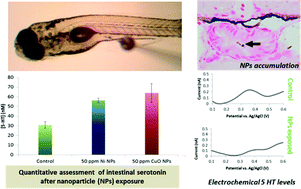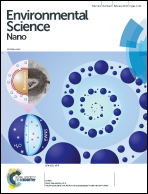Alterations of intestinal serotonin following nanoparticle exposure in embryonic zebrafish†
Abstract
The increased use of engineered nanoparticles (NPs) in manufacturing and consumer products raises concerns about the potential environmental and health implications on the ecosystem and living organisms. Organs initially and more heavily affected by environmental NPs exposure in whole organisms are the skin and digestive system. We investigate the toxic effect of two types of NPs, nickel (Ni) and copper oxide (CuO), on the physiology of the intestine of a living aquatic system, zebrafish embryos. Embryos were exposed to a range of Ni and CuO NP concentrations at different stages of embryonic development. We use changes in the physiological serotonin (5HT) concentrations, determined electrochemically with carbon fiber microelectrodes inserted in the live embryo, to assess this organ dysfunction due to NP exposure. We find that exposure to both Ni and CuO NPs induces changes in the physiological 5HT concentration that varies with the type, exposure period and concentration of NPs, as well as with the developmental stage during which the embryo is exposed. These data suggest that exposure to NPs might alter development and physiological processes in living organisms and provide evidence of the effect of NPs on the physiology of the intestine.


 Please wait while we load your content...
Please wait while we load your content...